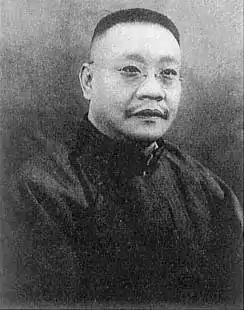Tan Yankai
Tan Yankai ([tʰǎn jɛ̌n kʰài]; Chinese: 譚延闓; January 25, 1880 – September 22, 1930) was a Chinese politician.
Tan Yankai | |
|---|---|
譚延闓 | |
 | |
| Chairman of the National Government of China | |
| In office 7 February 1928 – 10 October 1928 | |
| Preceded by | Zhang Zuolin (as President of the Beiyang Government) |
| Succeeded by | Chiang Kai-shek |
| Premier of the Republic of China | |
| In office 25 October 1928 – 22 September 1930 | |
| Preceded by | Pan Fu |
| Succeeded by | T. V. Soong |
| Personal details | |
| Born | 25 January 1880 Hangchow, Chekiang, Qing Dynasty |
| Died | 22 September 1930 (aged 50) Nanking, Kiangsu, Republic of China |
| Resting place | Linggu Temple |
| Nationality | Republic of China |
| Political party | Kuomintang |
| Other political affiliations | Progressive Party |
| Father | Tan Zhonglin |
| Tan Yankai | |||||||||||
|---|---|---|---|---|---|---|---|---|---|---|---|
| Traditional Chinese | 譚延闓 | ||||||||||
| Simplified Chinese | 谭延闿 | ||||||||||
| |||||||||||
Biography

Tan Yankai was born on 25 January 1880 in Hangzhou during the waning decades of the Qing dynasty. He was the son of the Qing minister Tan Zhonglin. A member of Liang Qichao's Constitutionalist Party, he campaigned for a parliament and restrained monarchy. As the party renamed itself the Progressive Party after the Xinhai Revolution, he was a major leader.
He left and joined the Kuomintang and became military governor of his home province. He remained neutral during Sun Yatsen's attempt to overthrow President Yuan Shikai in the 1913 Second Revolution, but Yuan removed him anyway. He returned to power after Yuan's death and led his province into resisting the Beiyang Army in 1917's Constitutional Protection War, which saved Sun's Guangdong base. After a brief attempt at spearheading federalism, his subordinates forced him to resign. When Chen Jiongming was driven out of Guangzhou, Tan was made home minister by Sun.
He served as Chairman of the National Government during the first half of the Northern Expedition and again during its conclusion. He was a member of Wang Jingwei's Wuhan faction and was the first internationally recognized head of state of the Nanjing-based Kuomintang government. The United States was the first major power to give recognition on October 1, 1928, though they had already given de facto recognition back in July. After the Organic Law came to effect on the Double Ten Day, he was succeeded by Chiang Kai-shek. Tan then became premier, a post he would hold until he died in office.
Death
He is entombed in the grounds of the Linggu Temple, near the Sun Yat-sen Mausoleum in Nanjing.
Personal life
His daughter, Tan Xiang, married Chen Cheng.
See also
| Wikimedia Commons has media related to Tan Yankai. |
| Political offices | ||
|---|---|---|
| Preceded by Chiang Kai-shek |
Chairman of the National Government 1927–1928 |
Succeeded by Chiang Kai-shek |
| Preceded by Zhang Zuolin |
Internationally recognized head of state 1928 |
Succeeded by Chiang Kai-shek |
| Preceded by Pan Fu |
Premier of the Republic of China 1928–1930 |
Succeeded by T. V. Soong |
| Educational offices | ||
| Previous: Chen Shufan (陈树藩) |
President of Hunan First Normal University September 1905-November 1906 |
Next: Liu Renxi (刘人熙) |